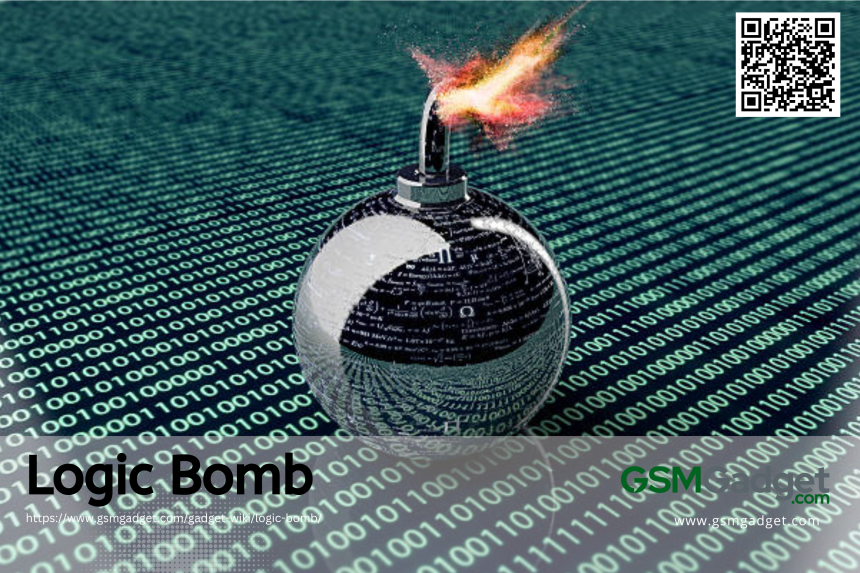A logic bomb is a form of malicious code that is covertly inserted into a software system in order to carry out a destructive action when specific conditions are met. Unlike viruses or worms, it remains inactive and undetectable until a triggering event occurs, such as a certain date, the modification or deletion of a file, or a specific action by a user. Once activated, the logic bomb releases its payload, which can result in anything from data corruption to the deletion of important files, causing significant operational disruption and data loss. The stealthy nature of logic bombs allows them to remain concealed, posing a serious threat that can exploit system vulnerabilities at critical moments, potentially enabling data theft, system harm, or widespread network disturbance.
Specification Table of Logic Bomb
| Specification Detail | Description |
| Name | Logic Bomb |
| Type | Malicious Software (Malware) |
| Trigger Mechanism | Specific conditions or events (e.g., a particular date and time, deletion of an employee’s account, a certain user action) |
| Payload | The malicious action that is executed when the trigger condition is met (e.g., deletion of files, corruption of data, locking of system) |
| Concealment | Often embedded within legitimate code to avoid detection |
| Detection Difficulty | High; often requires specific security tools or manual code audits |
| Common Deployment | Within an organization’s internal systems by a disgruntled employee or an attacker with internal access |
| Potential Targets | Any computer system or network where the attacker has sufficient access to embed the Logic Bomb |
| Intended Effect | Disruption of services, data loss, financial harm, sabotage |
| Activation Time | Can be immediate upon the occurrence of the trigger event or delayed to a specific time |
| Prevention | Regular code reviews, employee background checks, limiting access to critical systems, up-to-date security software |
| Legal Consequences | Criminal charges, fines, imprisonment |
| Ethical Considerations | Unethical and illegal; causes harm to individuals, organizations, and systems |
| Removal | Difficult without knowing the trigger; requires thorough system scans and possibly assistance from cybersecurity professionals |
| Examples of Triggers | Date-based (e.g., April 1st), action-based (e.g., launching a specific application), condition-based (e.g., when a certain file is not found) |
| Reporting | Incidents involving Logic Bombs should be reported to law enforcement and cybersecurity authorities |
History of Logic Bomb
The history of the logic bomb is deeply rooted in the early days of computing and gained notoriety during the Cold War era as a digital weapon of espionage and cyber-sabotage. Initially highlighted in a 1982 incident between the U.S. and the Soviet Union, where the CIA allegedly used it to cause substantial damage to Soviet pipeline systems, logic bombs are malicious programs that trigger destructive actions when certain conditions are met. These triggers, often time or event-based, remain hidden within a system’s code until activated. Over time, logic bombs have become more complex and are now a tool for various actors, from disgruntled employees seeking retribution to cyber-terrorists aiming to inflict widespread system damage. Their evolution underscores the persistent threat they pose in cyber warfare and corporate espionage, prompting advancements in detection and prevention within the cybersecurity industry.
Types of Logic Bombs
Logic bombs are a type of malicious code that is created to carry out a harmful action when certain conditions are met. Typically remaining inactive until activated, these deceptive pieces of code can cause significant damage to systems without prior notice. Below are some of the most prevalent types of logic bombs that users and administrators should be familiar with.
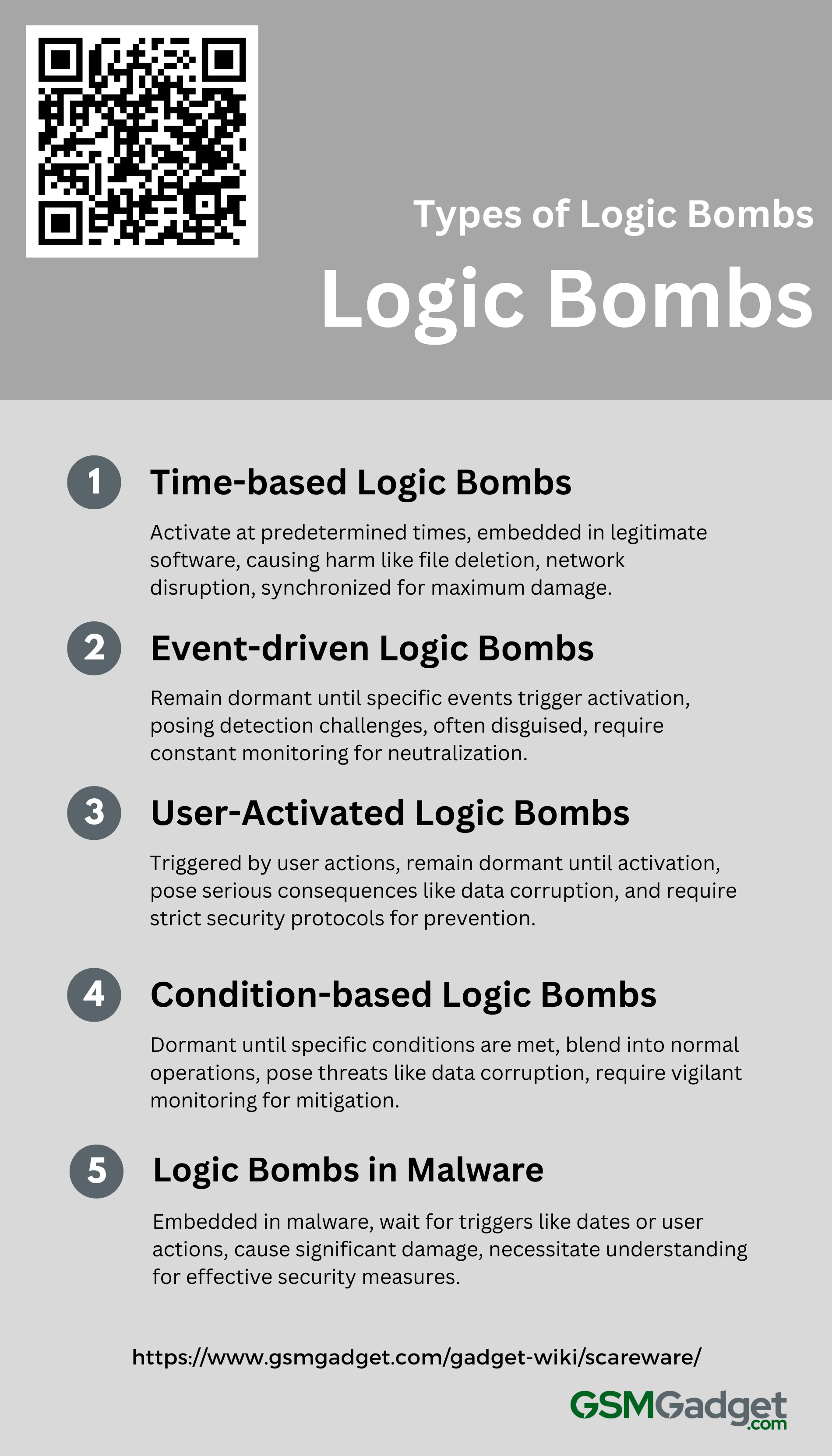
1. Time-based Logic Bombs
Time-based logic bombs are a particularly insidious form of malware designed to execute a malicious payload at a predetermined moment, often embedded within legitimate software. These dormant cyber threats activate based on the passage of time—whether at a specific date, after a countdown, or at regular intervals—without the need for user actions or system conditions to trigger them. Upon activation, they can cause significant harm by deleting files or disrupting network services, and their ability to remain undetected for long periods allows attackers to synchronize their attacks with key business events for maximum disruption. Their simplicity and potential for extensive damage make time-based logic bombs a dangerous weapon in the arsenal of cyber saboteurs.
2. Event-driven Logic Bombs
Event-driven logic bombs are a type of malicious software that remains dormant within a system until a specific event prompts their activation. These triggering events can range from a simple date and time occurrence to more complex conditions such as a user logging in, a file being accessed, or a network condition being met. The ability of these logic bombs to remain undetected until the precise trigger event occurs poses a significant security challenge. They often disguise themselves as harmless software or scripts, making their detection and removal more difficult. Unlike time-based logic bombs that activate at a predetermined time, event-driven logic bombs require constant monitoring and proactive security measures to identify and neutralize them before they cause harm.
3. User-Activated Logic Bombs
User-activated logic bombs are a harmful type of malicious software that remains dormant within a system until triggered by a specific user action, such as entering a command, opening a file, or failing to log in for a certain period of time. Designed to avoid detection until their activation conditions are met, these logic bombs can cause serious consequences such as data corruption or unauthorized disclosure of sensitive information. They pose a significant threat in situations involving cyber sabotage or as a means of retaliation by disgruntled insiders or external attackers. To prevent such harm, it is crucial to adhere to strict security protocols and regularly audit system operations, as these logic bombs can seamlessly blend into legitimate software applications, making them challenging to identify and requiring diligent software management and robust cybersecurity measures.
4. Condition-based Logic Bombs
Condition-based logic bombs are a type of malicious code that are designed to remain dormant within a system’s legitimate processes until specific conditions are met. These conditions can range from simple cues, such as a specific date and time, to more complex events like the launch of an application or a particular user’s login. The ability of these logic bombs to go undetected until activated poses a significant threat, as they can cause data corruption, system disruption, or unauthorized data access. Their specificity allows them to blend in with normal operations, making it necessary to implement heightened security measures and vigilant monitoring in order to prevent and mitigate the potential damage to both individual and organizational IT systems.
5. Logic Bombs in Malware
Logic bombs are a type of malicious code found within malware that remain inactive in software or systems until specific conditions prompt their activation. These conditions can range from a particular date, user action, or system event, such as an employee being removed from payroll. Unlike viruses and worms, logic bombs do not spread on their own but instead wait for their trigger to carry out harmful actions, such as deleting files, corrupting data, or even wiping entire hard drives. Due to their potential for causing significant damage and disruption, as well as their ability to avoid detection, logic bombs are considered a serious threat. Cybersecurity professionals must comprehend the behavior of logic bombs in order to establish effective security measures and reduce the risks they present, as they can be utilized independently or in conjunction with other malware to amplify their destructive capabilities.
Examples of Logic Bomb
In the field of cybersecurity, a logic bomb is a malicious piece of code created to carry out harmful actions when certain conditions are fulfilled. Typically remaining inactive until activated, these bombs have the potential to cause substantial harm to systems and data. The following examples demonstrate the varied and secretive characteristics of logic bombs in the technology industry.
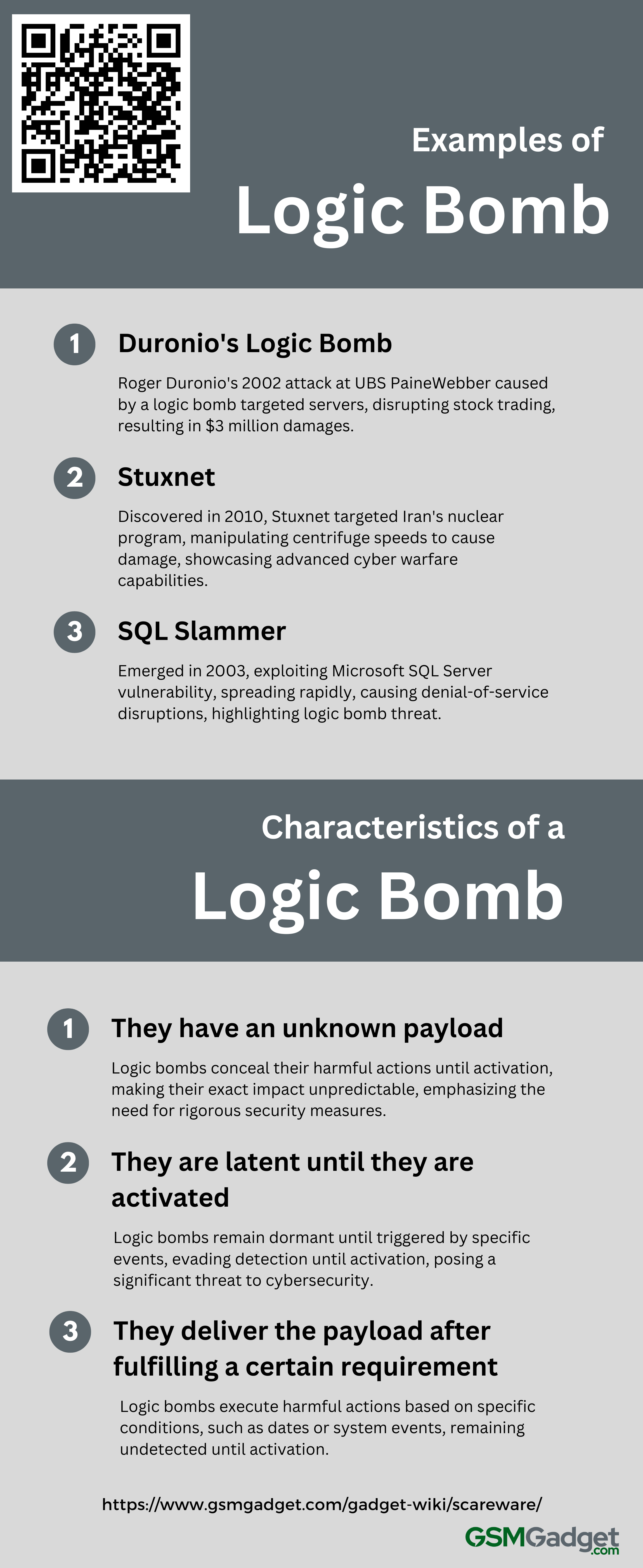
1. Duronio’s Logic Bomb
In 2002, Roger Duronio, a systems administrator at UBS PaineWebber, carried out a well-known cyberattack by inserting a logic bomb into the company’s network as retribution for a bonus that was lower than expected. The bomb was programmed to activate on a specific date and targeted more than 2,000 servers, deleting important files to disrupt stock trading and attempting to lower the company’s stock price—a move Duronio wagered on with put options. Despite his actions, the stock price remained steady, but the attack resulted in an estimated $3 million in damages and necessitated a significant recovery effort involving over 200 IBM technicians. Duronio’s subsequent conviction for computer and securities fraud highlights the serious dangers and consequences associated with internal cybersecurity threats, underscoring the importance of strict security measures and vigilant monitoring of employees within organizations.
2. Stuxnet
Stuxnet, a well-known logic bomb discovered in 2010, demonstrates the advanced capabilities of cyber warfare by targeting SCADA systems specific to Iran’s nuclear program. Designed to infect Siemens Step7 software on Windows, it remained dormant until it found its specific target—uranium enrichment centrifuges at Iran’s Natanz facility. Once activated, Stuxnet covertly manipulated the centrifuges’ rotational speed to cause physical damage, all while appearing to operate normally to monitoring systems. This carefully planned design, believed to be the work of U.S. and Israeli intelligence, ensured that it went unnoticed in non-target systems, showcasing the stealth and precision of such cyberweapons. The deployment of Stuxnet marked a significant moment in cyber-attack history, demonstrating how logic bombs can achieve complex, strategically important objectives with devastating effectiveness.
3. SQL Slammer
The SQL Slammer worm, also known as Sapphire, is a notable example of a logic bomb that caused significant damage in the cybersecurity field by exploiting buffer overflow vulnerability in Microsoft’s SQL Server in January 2003. Unlike traditional logic bombs that require a specific trigger, SQL Slammer rapidly spread by generating random IP addresses and infecting vulnerable systems, doubling its spread rate every few seconds and infecting approximately 75,000 victims within 10 minutes of its release. This aggressive spread did not involve a direct payload to corrupt files, but instead caused widespread denial-of-service disruptions, severely impacting global internet traffic. The activation mechanism of SQL Slammer, which remained inactive until encountering an unpatched system, highlights the potential for substantial damage when logic bombs are deployed, emphasizing their threat to the stability of cyberspace.
Characteristics of a Logic Bomb
A logic bomb is a form of malicious software that initiates a harmful action when certain conditions are fulfilled. Typically remaining inactive until triggered, these deceptive cyber threats have the potential to inflict substantial harm on data and systems. In the following section, we will examine the essential features that distinguish a logic bomb and its functioning within a compromised host.
1. They are latent until they are activated
Logic bombs are a type of malicious code that remains inactive within a system, evading detection by security software until a specific event prompts their activation. These triggers can vary greatly, such as a predetermined date, specific user actions, or the removal of critical files. Once activated, logic bombs release destructive payloads that can delete files, corrupt data, or disable entire networks. The secretive nature of logic bombs presents a significant threat, often intended to cause maximum disruption at a strategically chosen time. As a result, IT professionals must implement rigorous security measures and remain vigilant in order to identify and neutralize these hidden dangers before they cause chaos in both corporate and personal computing environments.
2. They have an unknown payload
The defining characteristic of a logic bomb is its hidden payload, which remains undisclosed and unpredictable until activated by specific conditions. This payload has the potential to execute a variety of harmful actions, such as deleting important files or releasing malware, making the logic bomb a significant threat to digital infrastructure. The inability to predict the exact nature of the payload increases the risk, as organizations may not be aware of the impending damage until it is too late, emphasizing the importance of strict security measures and continuous monitoring. The design of a logic bomb takes advantage of the element of surprise to maximize its impact, highlighting the difficulty of proactive defense in the constantly changing landscape of cybersecurity threats.
3. They deliver the payload after fulfilling a certain requirement
Logic bombs are a type of malicious software designed to execute a harmful action when specific conditions are met. They remain inactive within a system’s infrastructure until triggered, allowing them to avoid detection by users and antivirus programs. The conditions for activating a logic bomb can vary, such as specific dates, file modifications, or system events like user logins. Once the conditions are met, the logic bomb carries out its harmful action, which can include data corruption, file deletion, or compromising system integrity. These actions are often timed to cause maximum damage during critical events. The ability of logic bombs to go undetected until activation makes them powerful tools for targeted cyber-attacks, with their unpredictability and potential for sudden, significant disruptions or data breaches increasing their threat level.
Difference between a Logic Bomb and a Time Bomb
In cyber security, logic bombs and time bombs are two distinct types of malicious software known for their unique activation triggers. A logic bomb executes its harmful payload when specific conditions are met, such as the deletion of an employee’s credentials or a particular system event, making it versatile and unpredictable. On the other hand, a time bomb is set off at a predetermined moment, making its timing predictable but its impact no less threatening. Both types of malware can remain undetected until their respective conditions are fulfilled. Cyber security professionals must understand these differences in order to effectively detect and neutralize the threats they pose through vigilant monitoring and robust preventive measures.
Results of Logic Bombs
The insidious nature of logic bombs lies in their ability to remain dormant within a system, only to initiate destructive actions when specific conditions are met. These hidden pieces of code can compromise data integrity, disrupt operations, and cause lasting harm to an organization’s digital infrastructure. Here, we outline the various outcomes that can result from the activation of logic bombs in a technological setting.
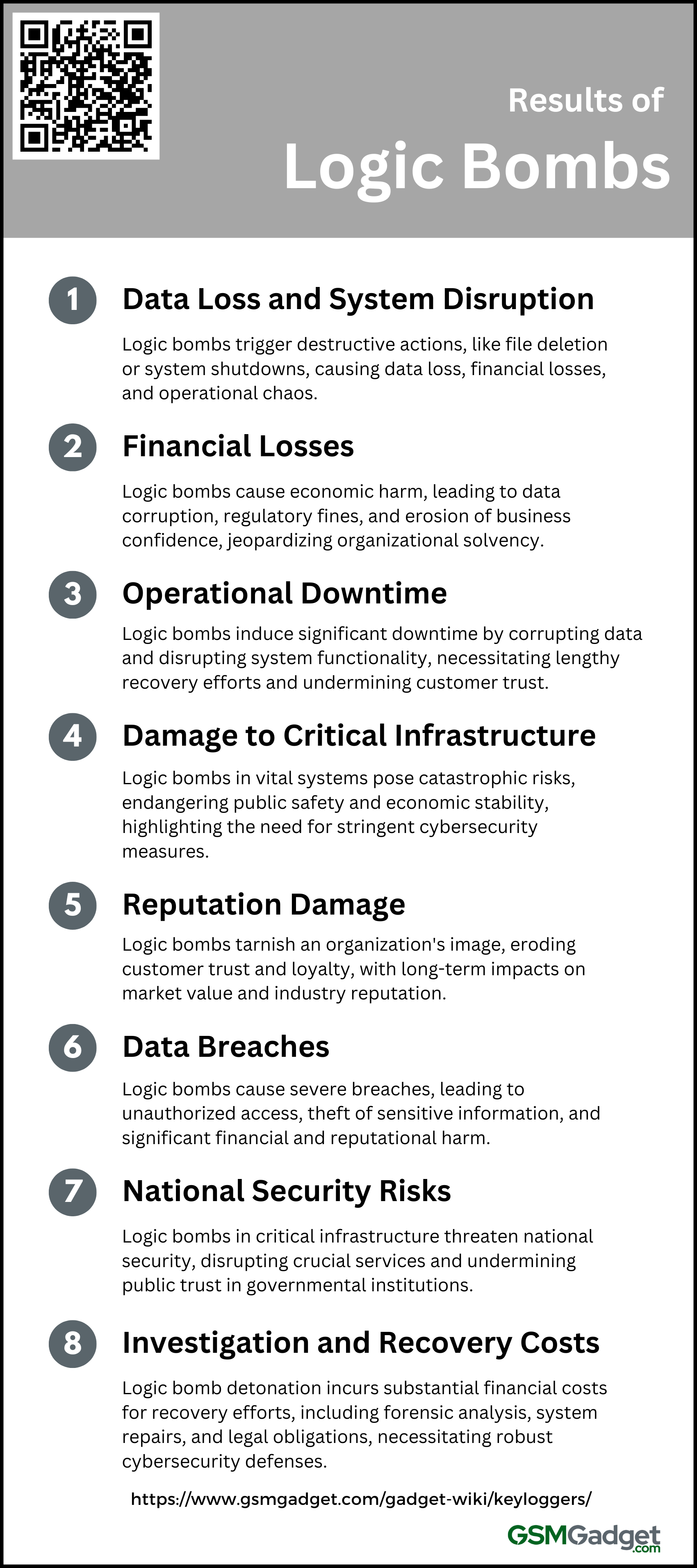
1. Data Loss and System Disruption
Logic bombs, a type of malicious code, are designed to carry out destructive actions within a computer system when specific conditions are met, such as the passage of time or user interactions. These conditions, once triggered, can result in the deletion or corruption of important files and databases, or even the complete reformatting of hard drives, causing irreversible harm to an organization’s digital infrastructure. The impact of a logic bomb is far-reaching, not only disrupting business operations and causing technical chaos, but also leading to financial losses, potential legal consequences, and harm to a company’s reputation. Instances like the 2006 UBS logic bomb attack highlight the importance of strong cybersecurity defenses to proactively detect and address these hidden threats.
2. Financial Losses
Logic bombs, insidious forms of malicious software, pose a severe threat to organizational financial stability when activated. These hidden codes are programmed to launch destructive actions such as data corruption, file deletion, or complete system shutdowns once specific conditions are met. The financial consequences of such attacks extend beyond immediate system repair and data recovery costs, encompassing regulatory fines, legal expenses, and the erosion of business and consumer confidence. Notably, the 2006 UBS incident, where a disgruntled employee caused massive losses, exemplifies the potential for these attacks to jeopardize an organization’s solvency. This underscores the imperative for robust cybersecurity protocols to preemptively identify and disarm logic bombs, thereby safeguarding against profound economic harm.
3. Operational Downtime
Logic bombs are malicious code that are covertly embedded and trigger significant operational downtime by executing a destructive payload under specific conditions. They often go undetected until it is too late. Their activation can result in data corruption, deletion of critical files, and disruption of system functionality, leading to a cascade of failures that halt business operations. The resulting downtime goes beyond the immediate service stoppage, requiring a lengthy recovery phase to restore system and data integrity. These incidents can cause substantial financial losses, damage to reputation, and loss of customer trust, underscoring the critical importance of robust security measures and proactive monitoring to address these hidden cyber threats proactively.
4. Damage to Critical Infrastructure
The surreptitious deployment of logic bombs in critical infrastructure systems, such as power grids, water networks, and transportation systems, presents a significant threat with the potential for catastrophic consequences. These covert cyber weapons, designed to trigger destructive actions when specific conditions are met, can lead to temporary disruptions or prolonged system failures, endangering public safety, economic stability, and trust in digital services. Notable incidents like the Stuxnet attack, which caused physical damage to Iran’s nuclear centrifuges, and the UBS server sabotage, which resulted in substantial financial losses, underscore the serious national security risks. These events emphasize the need for stringent cybersecurity measures, including robust security protocols and continuous monitoring, to protect against such covert attacks and ensure the uninterrupted functioning of essential societal operations.
5. Reputation Damage
The stealthy nature of logic bombs presents a significant threat to the reputation of organizations, as these malicious codes lie dormant within information systems until a specific trigger activates them. Once triggered, they can cause severe data corruption, operational disruptions, and breaches of security protocols. These incidents not only tarnish the organization’s public image but also undermine customer trust and confidence, potentially resulting in significant financial and legal consequences. In the technology sector, where ensuring data integrity and system reliability is crucial, the damage caused by logic bombs can have long-lasting and far-reaching effects. This can erode years of established credibility and customer loyalty, with the potential for more profound impacts on market value and industry reputation than the immediate costs of IT repairs.
6. Data Breaches
Logic bombs are a type of malicious code that are covertly inserted into software systems with the purpose of causing harm when specific conditions are met, such as a particular date or event like an employee’s termination. These hidden threats remain dormant until activated, resulting in serious data breaches involving unauthorized access to and theft of sensitive information. The repercussions of such breaches are severe, including the compromise of personal and financial data, theft of intellectual property, and potential legal consequences. Organizations suffer significant financial and reputational harm, and the recovery process requires extensive efforts to repair and secure systems, as well as to regain trust among stakeholders. The unpredictable nature of logic bombs poses a major challenge for cybersecurity, underscoring the importance of constant vigilance, timely software updates, and robust security measures to effectively detect and prevent these hidden dangers.
7. National Security Risks
Logic bombs, which are stealthy and malicious code, present significant national security risks when inserted into critical infrastructure such as power grids, financial systems, or defense networks. These threats can lay dormant, evading detection until a specific condition triggers a harmful activation, disrupting crucial services, compromising sensitive data, and undermining public trust in governmental institutions. The consequences of such cyber-attacks are far-reaching, with the potential to disrupt geopolitical stability, weaken economic foundations, and incite widespread chaos. The well-known Stuxnet attack on Iran’s nuclear facilities serves as a prime example of the destructive capabilities of logic bombs and the susceptibility of essential systems to cyber sabotage. This highlights the necessity for governments to enforce rigorous cyber security measures to identify, neutralize, and prevent the activation of logic bombs, safeguarding both national and international security interests.
8. Investigation and Recovery Costs
The detonation of a logic bomb within an organization’s IT infrastructure can result in severe financial consequences, as recovery and investigation efforts can incur significant costs. A thorough forensic analysis is necessary to identify the origin of the logic bomb, examine its payload, and determine the extent of the damage, often requiring the expertise of cyber security professionals. The financial impact includes not only direct technical remediation, such as system repairs, data recovery, and security upgrades, but also indirect costs like revenue loss, legal obligations, and damage to reputation. Illustrated by a case on March 4th, 2002, where a logic bomb caused more than $3 million in damages, these incidents underscore the importance of strong cyber security defenses and regular system audits to reduce risks and ensure readiness for such attacks.
Detection of Logic Bomb
The insidious nature of a logic bomb lies in its ability to remain dormant within a system until triggered by a specific event. In the field of cybersecurity, detecting these malicious code snippets is crucial for protecting information integrity and operational continuity. Below, we outline the essential steps to identify and neutralize potential logic bombs before they cause harm.
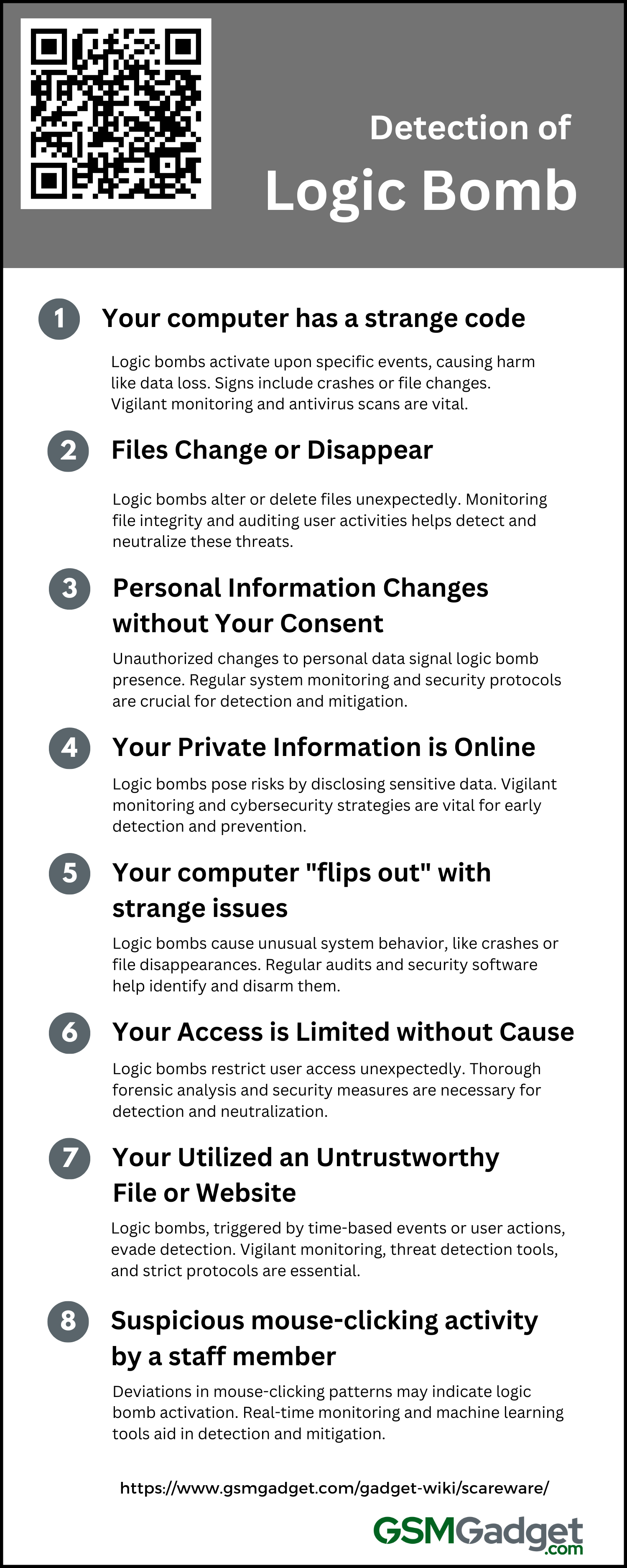
1. Your computer has a strange code
Detecting a logic bomb, a type of malicious code that remains dormant within a computer system until a specific event activates it, is essential for maintaining cybersecurity. These events can range from a set date, the revocation of an employee’s credentials, or the execution of a particular program, resulting in potential harm such as data loss or system malfunction. Signs of a logic bomb may manifest as unexpected system crashes, decreased performance, or unusual error messages. To detect and eliminate these threats, it is crucial to regularly scan the system using up-to-date antivirus software, monitor system logs and scheduled tasks for anomalies, and establish a comprehensive cybersecurity plan with frequent updates and patches. Diligent security measures, such as code reviews and intrusion detection systems, play a critical role in identifying and mitigating the dangers posed by these hidden cyber threats.
2. Files Change or Disappear
In the technical field of cybersecurity, the detection of a logic bomb, a type of malicious code that activates under specific conditions, relies on vigilant monitoring for unexpected file changes or disappearances. These threats, which can result in unauthorized data alteration or loss, are often hidden within legitimate programs and are designed to activate at particular times or events. To address these concealed risks, IT professionals use file integrity monitoring systems to notify them of unauthorized changes, in addition to comprehensive auditing tools that document user activities. By implementing rigorous system checks and closely monitoring file behavior, organizations can identify and neutralize a logic bomb before it causes harm, thus safeguarding their digital assets from these hidden threats.
3. Personal Information Changes without Your Consent
The unauthorized alteration of personal information within a system, such as unexpected modifications to user profiles, passwords, or access rights without consent, is a clear indication of the presence of a logic bomb. These covert threats are created to go unnoticed while they undermine security and inflict harm. To combat logic bombs, it is crucial to consistently monitor system activities for indicators such as abnormal data modification timestamps, atypical account activity, and unauthorized access notifications. Enhancing defenses with thorough security protocols, such as multi-factor authentication and routine system permission evaluations, is essential for detecting and safeguarding against the malicious impacts of logic bombs.
4. Your Private Information is Online
Logic bombs, a type of malicious code, present a significant risk to the security of private information online as they can go undetected within systems until triggered by specific conditions, such as a predetermined date or event. These hidden threats can result in the unauthorized disclosure of sensitive data, highlighting the importance of implementing vigilant monitoring systems, such as intrusion detection systems (IDS), for early detection and prevention of potential harm. To mitigate the dangers associated with logic bombs, it is crucial to adopt comprehensive cybersecurity strategies that involve regular updates to antivirus software, secure coding practices, and educating users on identifying potential triggers. Taking proactive measures is essential to safeguard personal and sensitive information from the devastating impacts of these clandestine digital threats.
5. Your computer “flips out” with strange issues
When a computer system is compromised by a logic bomb, it may display a variety of strange and unexplained behaviors, including sudden crashes, error messages, slowdowns, or the disappearance of files. These malicious code snippets are programmed to activate under specific conditions, such as a particular date, the launch of an application, or the deletion of a critical file or an employee from payroll, and can go unnoticed for long periods of time. To effectively identify a logic bomb, it is crucial to engage in vigilant monitoring, conduct regular system audits, and utilize security software capable of detecting unusual code patterns. IT professionals often rely on system auditing tools to locate the source of the abnormal behavior, which is essential for disarming the logic bomb and preventing potential harm to system functionality and data integrity.
6. Your Access is Limited without Cause
In the cybersecurity domain, logic bombs present a hidden yet significant threat, acting as a dormant time bomb within an organization’s IT systems. These malicious pieces of code are created to carry out destructive actions under specific conditions, such as the passage of time or particular system events. The sudden restriction of user access may indicate the activation of a logic bomb, requiring immediate and thorough forensic analysis and system audits to identify the origin, assess the impact, and neutralize the threat. Because logic bombs can go undetected by remaining inactive until triggered, they often elude traditional antivirus solutions. To combat this, organizations should implement advanced security measures, including routine audits, in-depth log analysis, and anomaly detection software to uncover unauthorized code modifications and protect system integrity.
7. Your Utilized an Untrustworthy File or Website
In the cybersecurity field, the detection of logic bombs, which are malicious code designed to carry out harmful actions under specific conditions, presents a significant challenge. This challenge is particularly pronounced when these threats originate from unreliable files or websites. These covert dangers can be triggered by either time-based events or user actions, and they often manage to evade detection by traditional antivirus software by disguising themselves as benign code. The inadvertent use of insecure sources for downloading files or accessing websites greatly increases the likelihood of a system being infiltrated by logic bombs. To address this issue, it is crucial to utilize advanced threat detection tools, maintain vigilant monitoring practices, and adhere to strict cybersecurity protocols. This includes downloading files from reputable sources, utilizing secure websites with HTTPS encryption, and regularly updating security software. These proactive measures are essential for identifying and neutralizing logic bombs before they are able to carry out their destructive intentions.
8. Suspicious mouse-clicking activity by a staff member
In cybersecurity, the detection of a logic bomb, which can be triggered by deviations in mouse-clicking patterns from a staff member’s usual workflow, requires constant monitoring. These unusual clicking behaviors, particularly when not accompanied by keyboard input, may indicate a logic bomb programmed to activate under specific circumstances, such as repeated access to a file. To combat these threats, organizations employ advanced tools with machine learning capabilities to distinguish between normal and suspicious activities, allowing IT security teams to promptly identify and neutralize potential logic bombs. Regular system audits and real-time monitoring of user activity are crucial elements of these sophisticated cybersecurity protocols, ensuring the safeguarding of the organization’s digital assets against such hidden malware attacks.
Prevention of Logic Bomb
Logic bombs, a type of covert sabotage code, have the potential to cause severe damage when specific conditions are met. The following is a compilation of strategies to successfully eliminate these concealed threats before they have the opportunity to cause harm to your systems.
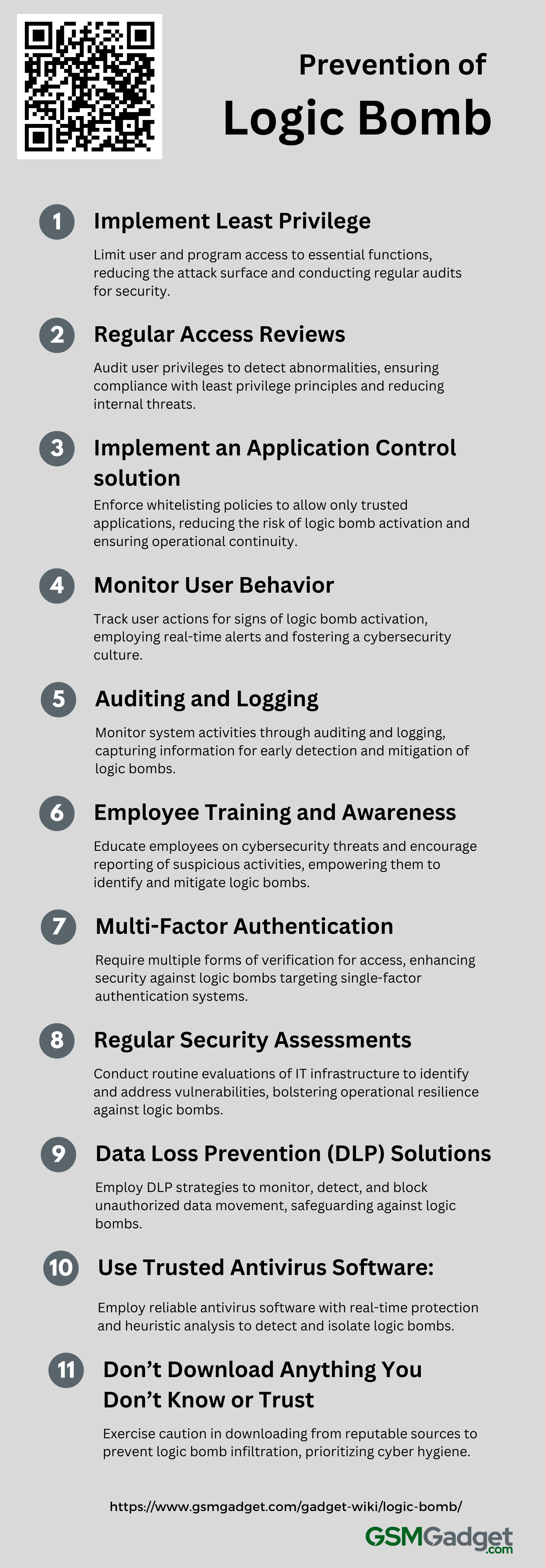
1. Implement Least Privilege
Enforcing the Principle of Least Privilege (PoLP) is crucial for defending against logic bombs, which are malicious code segments designed to execute under specific conditions. System administrators can reduce potential harm by ensuring that both users and programs have only the necessary access rights to perform their functions. This approach not only limits access to critical system components but also reduces the attack surface, making it more difficult for attackers to deploy such threats. Regular audits and reviews of user permissions are essential to enhance security by identifying and correcting any overly permissive access rights, strengthening the system’s resilience against these hidden cyber threats. Maintaining a secure environment through vigilant access control and monitoring is essential for mitigating the risks associated with logic bombs.
2. Regular Access Reviews
Regular access reviews are a crucial defense strategy for preventing the threat of logic bombs, which are malicious code segments covertly inserted to initiate harmful actions under specific circumstances. By thoroughly auditing user privileges and analyzing access patterns, organizations can identify and correct any abnormalities or unnecessary permissions that could be exploited for the insertion of such code. This systematic examination ensures compliance with the principle of least privilege and is essential for detecting potential internal threats, thereby reducing the attack surface available to potential intruders. Ultimately, these reviews strengthen the security framework of an enterprise by maintaining strict control over who can access critical systems and data, playing a key role in improving the organization’s overall security posture.
3. Implement an Application Control solution
Implementing an Application Control solution is an important defensive measure for preventing logic bombs, which are malicious code segments that carry out unauthorized actions under specific conditions. By allowing only approved and trusted applications to run, this solution acts as a gatekeeper, enforcing a whitelist policy that prevents unapproved software and significantly reduces the risk of logic bomb activation. The strict control of application execution not only addresses known threats but also defends against zero-day exploits and advanced threats by taking a default-deny approach. Application Control’s strong security features, such as privilege management and detailed access controls, are crucial for ensuring operational continuity and safeguarding the integrity of sensitive data within an organization’s digital infrastructure.
4. Monitor User Behavior
In order to reduce the risk of logic bomb attacks, which are malicious code that is triggered under specific conditions, organizations should implement vigilant user behavior monitoring and robust activity tracking systems. By establishing baselines for user behavior and following the principle of least privilege, IT professionals can detect and respond to signs of logic bomb activation, such as unusual login times, unauthorized access to sensitive data, or abnormal script executions. Regular audits and real-time alerts are crucial for early detection of these threats, while fostering a strong cybersecurity culture helps employees identify and report suspicious activities. These strategies together create a comprehensive defense, significantly lowering the likelihood of logic bomb attacks and safeguarding the organization’s digital infrastructure from unauthorized manipulation or destruction.
5. Auditing and Logging
The prevention of logic bombs is crucial, requiring a comprehensive approach that emphasizes auditing and logging. These practices allow organizations to closely monitor system activities, capturing detailed information on user actions, system changes, and data modifications to identify any abnormal behavior indicative of a logic bomb. Auditing and logging serve as a combined guard, providing both real-time monitoring and a historical record necessary for tracing the origins of an attack and understanding its consequences. By conducting regular audits and maintaining detailed logs, organizations can detect and address vulnerabilities early, preventing potential harm. It is essential to ensure that these systems are fully implemented in all critical and sensitive areas to effectively defend against the stealthy and destructive nature of logic bombs.
6. Employee Training and Awareness
The prevention of logic bombs, which are malicious code activated under specific conditions, is crucially dependent on thorough employee training and a culture of security awareness. Organizations should educate their staff on basic cyber threats, best practices in software development, and network management, while also conducting regular training sessions on how to recognize signs of logic bombs, such as unusual system behavior or unauthorized code changes. Encouraging employees to report suspicious activities further strengthens this frontline defense. A comprehensive training program that includes practical examples and updates on the latest cybersecurity threats is essential to empower employees to identify and mitigate these hidden dangers, thereby significantly reducing the risk of operational disruptions caused by logic bombs.
7. Multi-Factor Authentication (MFA)
Multi-Factor Authentication (MFA) is a crucial strategy for reducing the risks associated with logic bombs, which are malicious code that activates under specific conditions to carry out harmful actions. MFA enhances security by requiring multiple forms of verification, such as a password, a mobile device for tokens, and biometric data. This complicates the authentication process and decreases the likelihood of unauthorized access that could trigger a logic bomb. This multi-layered defense is particularly effective against logic bombs that target single-factor authentication systems, creating a strong barrier that is difficult for attackers to bypass. As a result, MFA is essential for preserving system integrity and safeguarding sensitive information from the potentially devastating effects of logic bombs, thereby enhancing protection against both external and insider threats.
8. Regular Security Assessments
The deceptive nature of logic bombs requires proactive defense strategies, with regular security assessments serving as a crucial defense mechanism to uphold organizational integrity. These assessments, which should be a fundamental aspect of routine maintenance, entail thorough evaluations of IT infrastructure, including code reviews, software updates, and vulnerability scanning, to identify and address potential vulnerabilities. Comprehensive vulnerability scans and penetration testing play a vital role in detecting anomalies or unauthorized changes that may indicate the presence of a logic bomb. Adhering to industry standards through these assessments further bolsters an organization’s security posture. Moreover, providing IT staff with ongoing training on the latest cybersecurity practices enables them to effectively identify and respond to security threats, thereby enhancing operational resilience against a wide range of cyber threats.
9. Data Loss Prevention (DLP) Solutions
To effectively prevent the activation of logic bombs malicious code that causes harm when certain conditions are met a robust Data Loss Prevention (DLP) strategy is essential. DLP solutions are key in safeguarding against such threats by employing deep content inspection and understanding the context of data usage to monitor, detect, and block sensitive information from being transferred outside corporate networks. They continuously monitor data movement across networks, endpoints, and cloud services, identifying and preventing unauthorized access, sharing, or modification of sensitive data. By enforcing stringent policies and controls that are tailored to an organization’s specific data handling needs, DLP systems not only avert unauthorized data exfiltration but also protect against the potentially catastrophic effects of logic bombs, thus maintaining the integrity and confidentiality of digital assets.
10. Use trusted antivirus software
Employing trusted antivirus software is a fundamental strategy for thwarting logic bombs, a type of malware that remains inactive until a specific condition triggers its harmful payload. These antivirus programs are indispensable for their ability to offer real-time protection and heuristic analysis, which are bolstered by frequent updates to combat the latest threats. They work by meticulously examining code for irregularities and observing system behavior to identify and isolate any suspicious activities. The integration of automatic scanning and file quarantine features further reinforces system defenses, protecting vital infrastructure from the severe consequences of a logic bomb’s activation. Complementing antivirus software with additional security measures, such as conducting regular system audits, implementing access controls, and maintaining vigilant system monitoring, is crucial to fortify the overall defense against these covert and destructive threats.
11. Don’t download anything you don’t know or trust
To safeguard against logic bombs, malicious software that executes harmful actions under specific conditions, it is imperative to exercise discernment in your download habits. Ensuring the prevention of these threats requires a strict protocol of obtaining software and files solely from reputable and trusted sources. Vigilance is key—confirms the authenticity and integrity of downloads through digital signatures or checksums, maintain up-to-date antivirus software, and cultivate a cyber-security-aware culture. By being cautious and informed, individuals and organizations can effectively shield their digital environments from the potentially catastrophic impact of logic bombs, adhering to the principle of “better safe than sorry” in the realm of cyber security.
